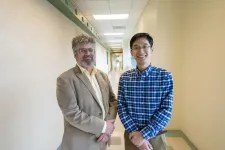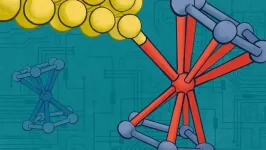(Press-News.org) Beckman Institute for Advanced Science and Technology researchers Jonathan Sweedler, a professor of chemistry, and Fan Lam, a professor of bioengineering, outlined how spatial omics technologies can reveal the molecular intricacy of the brain at different scales.
Their research appeared this month in Nature Methods.
The researchers and their colleagues used a biochemical imaging framework integrated with deep learning to create 3D molecular maps with cell specificity to better understand how the brain functions in health and disease. Their research is supported by a $3 million grant from the National Institute on Aging of the National Institutes of Health.
“If you look at the brain chemically, it’s like a soup with a bunch of ingredients,” Lam said. “Understanding the biochemistry of the brain, how it organizes spatiotemporally, and how those chemical reactions support computing is critical to having a better idea of how the brain functions in health as well as during disease.”
To understand how the brain’s chemical ingredients interact with one another, the researchers used a new imaging technique called mass spectrometry imaging to collect and analyze massive amounts of high-resolution data. They also used single-cell metabolomics and computational tools to extract data about individual molecules in single brain cells, which enabled data acquisition at unprecedented speeds and scales.
“Most people have a feeling that brain diseases such as depression and Alzheimer’s are caused by neurochemical imbalances,” Sweedler said. “But those imbalances are really hard to study and it’s difficult to understand how chemicals interact at different scales (for example, at the tissue level and individual cell level) during problems in the brain.”
According to Sweedler, creating 3D maps of chemical distributions with cell-type specificity enables researchers to further understand the complicated biochemistry within the brain, which in the long term should help address currently intractable neurological diseases.
Single-cell metabolomics, a technology critical to the researchers' findings, was named as one of Nature’s “Seven technologies to watch in 2023” along with CRISPR and the James Webb Space Telescope, speaking to the high impact these tools will continue to have as it relates to looking at cell-specific data, Sweedler said.
The research wouldn’t have been possible without the collaborative nature of the Beckman Institute.
“It truly amazes me how small interactions can turn into interesting research conversations and eventually into large-scale collaborative studies," said first author Richard Xie, a Beckman Institute Graduate Fellow. “The key is to be open-minded and interdisciplinary, as you may draw inspirations from another field. I feel very excited about the progress on leveraging different expertise across groups to engineer tools to better depict the biochemical landscape of the brain.”
Lam and Sweedler met at Xie's behest to discuss his work on single-cell and tissue mass spectrometry imaging. The team had a breakthrough in how informatics and computational methods could lead to a new kind of multimodal, multiscale biochemical imaging that’s highlighted in their recent Nature Methods paper.
Editor's notes:
The research described in this article, titled "Multiscale biochemical mapping of the brain through deep-learning-enhanced high-throughput mass spectrometry," can be access online at https://doi.org/10.1038/s41592-024-02171-3.
Full author information is available in the paper.
Research reported in this press release was supported by the National Institute on Aging of the National Institutes of Health under award number R01AG078797. The content is solely the responsibility of the authors and does not necessarily represent the official views of the National Institutes of Health.
Media contact: Jenna Kurtzweil, kurtzwe2@illinois.edu
END
Painting a molecular portrait of the brain with mass spectrometry and deep learning
Researchers used a biochemical imaging framework integrated with deep learning to create 3D molecular maps to better understand how the brain functions in health and disease
2024-03-05
ELSE PRESS RELEASES FROM THIS DATE:
Semaglutide reduces severity of common liver disease in people with HIV
2024-03-05
WHAT:
A weekly injection of semaglutide was safe and reduced the amount of fat in the liver by 31% in people with HIV and metabolic dysfunction-associated steatotic liver disease (MASLD), according to a presentation today at the 2024 Conference on Retroviruses and Opportunistic Infections (CROI) in Denver. This is the first clinical trial of semaglutide for MASLD in people with HIV. The research was sponsored by the National Institute of Allergy and Infectious Diseases (NIAID), part of the National Institutes of Health, and conducted in the United States and Brazil by ACTG, a global clinical trials network focused on HIV and other infectious diseases. ...
The Lancet: Experts warn about the overmedicalisation of menopause and call for a new approach to how society views menopause and supports women as they age
2024-03-05
The Lancet: Experts warn about the overmedicalisation of menopause and call for a new approach to how society views menopause and supports women as they age
Menopause is a life stage for half the world’s population and is generally depicted in a negative way. However, women’s experiences of menopause are unique and vary hugely.
The Lancet 2024 Series on menopause argues that an over-simplified narrative of menopause as a health problem to be solved by replacing hormones is not based on evidence and deflects attention from the need for substantial societal shifts in how menopause, and midlife/older women in general, are viewed and treated around the world.
The ...
Researchers show that menopause does not always impact mental health
2024-03-05
A new review paper from authors at Brigham and Women’s Hospital and collaborators concludes that menopause does not uniformly elevate the risk of depression and other mental health conditions.
Menopause has long been thought to cause psychological distress, but a new review suggests that this is not always the case. The review, written by experts from Brigham Women’s Hospital, a founding member of the Mass General Brigham healthcare system, and international collaborators, is the third in a series of menopause-themed papers published in The ...
Evolving hydrogen-storage technology: guidelines developed for the design of anti-evaporation catalysts
2024-03-05
1. A research team consisting of NIMS and the Tokyo Institute of Technology has identified materials capable of catalyzing the conversion of ortho-hydrogen to para-hydrogen. These catalysts should be essential to the spread of mass-transportation/storage of liquid hydrogen.
2. Hydrogen is becoming widely accepted as an alternative energy source to fossil fuels. Its liquefaction (at temperatures below -253°C under pressures higher than one atmosphere) can dramatically reduce its volume, making it suitable for transportation and storage. Hydrogen molecules (H2)—each composed of two hydrogen atoms—exist in two isomeric forms: ortho- and para-H2. Under normal conditions, ...
Early retirement impacts mental health of blue-collar women more than white-collar peers
2024-03-05
Retirement is a major transition that can have a significant impact on a person’s life.
For some, retirement evokes thoughts of slowing down, relaxing, and enjoying more of what life has to offer. For others, ending a regular work schedule can create stress and uncertainties about being able to pay necessary bills and maintain adequate medical care.
A new study by researchers at the Yale School of Public Health examines how retirement affects mental health and related inpatient mental health care among female workers in China, ...
A smart molecule beats the mutation behind most pancreatic cancer
2024-03-05
FOR IMMEDIATE RELEASE
Media Contact: LEVI GADYE (628) 399-1046
Levi.Gadye@ucsf.edu
Subscribe to UCSF News
A Smart Molecule Beats the Mutation Behind Most Pancreatic Cancer
Scientists discover a new way to disarm a deadly protein that also appears in cancers of the lung, breast and colon.
UC San Francisco researchers have designed a candidate drug that could help make pancreatic cancer, which is almost always fatal, a treatable, perhaps even curable, condition.
The new molecule permanently modifies a wily cancer-causing ...
Using light to precisely control single-molecule devices
2024-03-05
In a new Nature Communications study, Columbia Engineering researchers report that they have built highly conductive, tunable single-molecule devices in which the molecule is attached to leads by using direct metal-metal contacts. Their novel approach uses light to control the electronic properties of the devices and opens the door to broader use of metal-metal contacts that could facilitate electron transport across the single-molecule device.
The challenge
As devices continue to shrink, their electronic ...
Boston College researchers use electrocatalysis for site-specific protein modification
2024-03-05
Chestnut Hill, Mass. (03/05/2024) – Boston College researchers used a mild charge of electricity to precisely modify proteins, a new tool that can be used to develop novel biotherapeutics and protein-based research tools, the team reported recently in the journal Nature Chemistry.
The team, led by BC professors of chemistry Abhishek Chatterjee and Eranthie Weerapana, developed and optimized a novel electrochemical protein labeling reaction called "eCLIC", that enables precise modification of site-specifically incorporated 5-hydroxytryptophan (5HTP) residues on many different proteins including full-length therapeutic antibodies.
“We used this strategy to generate ...
Infotainment is coming for your news, warns Concordia Ph.D. student Robert Marinov
2024-03-05
There are plenty of reasons to worry about the quality of contemporary Canadian journalism, beyond shrinking newsrooms and attention spans.
Once considered a vital pillar of a healthy democracy, the country’s biggest newspapers have been embracing the type of content critics refer to as “infotainment,” which uses entertainment-style methods to communicate politically relevant information.
In a new paper published in the Canadian Journal of Political Science, PhD candidate Robert Marinov examines, measures and evaluates the scope and nature ...
Lab-grown liver organoid to speed up turtle research, making useful traits easier to harness
2024-03-05
AMES, Iowa – At a Biotechnology Council event a few years ago, Nicole Valenzuela’s ears perked up when she heard what a group of researchers in Iowa State University’s College of Veterinary Medicine had in the works: a method for creating a lab-grown, simplified mimic of dog intestines.
“I told them, ‘Oh! I want to do that but with turtles. Is it doable?” said Nicole Valenzuela, professor of ecology, evolution and organismal biology at Iowa State.
It is indeed doable, new research from a team led by Valenzuela shows. The three-dimensional clusters ...
LAST 30 PRESS RELEASES:
Decoupling the HOR enhancement on PtRu: Dynamically matching interfacial water to reaction coordinates
Sulfur isn’t poisonous when it synergistically acts with phosphine in olefins hydroformylation
URI researchers uncover molecular mechanisms behind speciation in corals
Chitin based carbon aerogel offers a cleaner way to store thermal energy
Tracing hidden sources of nitrate pollution in rapidly changing rural urban landscapes
Viruses on plastic pollution may quietly accelerate the spread of antibiotic resistance
Three UH Rainbow Babies & Children’s faculty elected to prestigious American Pediatric Society
Tunnel resilience models unveiled to aid post-earthquake recovery
Satellite communication systems: the future of 5G/6G connectivity
Space computing power networks: a new frontier for satellite technologies
Experiments advance potential of protein that makes hydrogen sulfide as a therapeutic target for Alzheimer’s disease
Examining private equity’s role in fertility care
Current Molecular Pharmacology achieves a landmark: real-time CiteScore advances to 7.2
Skeletal muscle epigenetic clocks developed using postmortem tissue from an Asian population
Estimating unemployment rates with social media data
Climate policies can backfire by eroding “green” values, study finds
Too much screen time too soon? A*STAR study links infant screen exposure to brain changes and teen anxiety
Global psychiatry mourns Professor Dan Stein, visionary who transformed mental health science across Africa and beyond
KIST develops eco-friendly palladium recovery technology to safeguard resource security
Statins significantly reduce mortality risk for adults with diabetes, regardless of cardiovascular risk
Brain immune cells may drive more damage in females than males with Alzheimer’s
Evidence-based recommendations empower clinicians to manage epilepsy in pregnancy
Fungus turns bark beetles’ defenses against them
There are new antivirals being tested for herpesviruses. Scientists now know how they work
CDI scientist, colleagues author review of global burden of fungus Candida auris
How does stroke influence speech comprehension?
B cells transiently unlock their plasticity, risking lymphoma development
Advanced AI dodel predicts spoken language outcomes in deaf children after cochlear implants
Multimodal imaging-based cerebral blood flow prediction model development in simulated microgravity
Accelerated streaming subgraph matching framework is faster, more robust, and scalable
[Press-News.org] Painting a molecular portrait of the brain with mass spectrometry and deep learningResearchers used a biochemical imaging framework integrated with deep learning to create 3D molecular maps to better understand how the brain functions in health and disease







